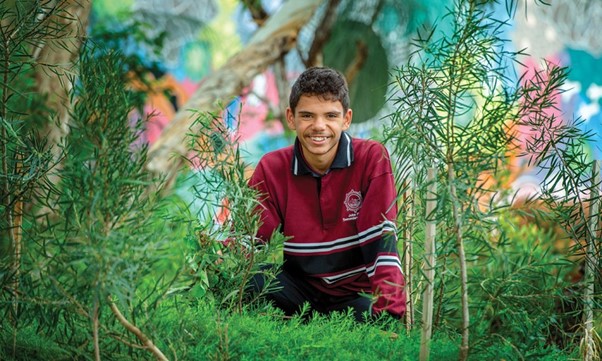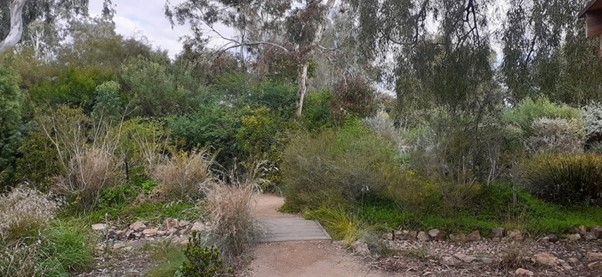
School graduate Mervyn Hudson was among the original group of students who helped build the garden and today continues to mentor others.
Students from a Port Pirie school have transformed an inhospitable piece of land into a special Indigenous garden.
With vibrant purple blooms, the Australian indigo (Indigofera australis) certainly stands out in the bush. But to First Nations people, it is more than simply a pretty flower. It is said the plant’s leaves and roots would be crushed and dropped into a water source to stun fish so they could be more easily caught. The beautiful indigo flowers could also be used to make a blue dye for colouring baskets.
The Australian indigo is one of many fascinating species located in a special garden inside the grounds of John Pirie Secondary School, which showcases plants that were used by First Nations people not just for food, but for medicine, tools, shelter, dyes, paints and for spiritual and ceremonial purposes.
The school obtained permission from Nukunu elders to name the garden Urumbula, which refers to a song line joining Spencer Gulf to the Gulf of Carpentaria.
The garden was founded in 2018 when retired teacher Bruce Mules began volunteering with Aboriginal students to transform a bare piece of land into an attractive and flourishing garden. The idea was to create a living classroom.
“You often hear about bush tucker, but that is just one of the many ways that Australia’s First Nations people use plants,” says Bruce.
“The aim of the garden is to celebrate the diversity of uses Aboriginal people have for plants and secondly, to give students the opportunity to be part of a program that encourages cultural learning, teamwork, physical skills and knowledge of horticulture and landscaping.”

The garden is filled with vibrant and varied species.
In particular, the garden is a way to help students who may have had trouble connecting with learning in the classroom. Bruce believes it has been a success for many.
“It provides a break from the classroom but is also something that helps some students to want to come to school, because they enjoy it,” he says. “It’s great to see students who might have had difficulty in the classroom, to switch on and engage.”
The garden – which is approximately the size of a soccer pitch – contains three environments: a dry creek bed, a rocky outcrop and desert sand dunes and harbours plants from across Australia. Closely edged with shrubs and grasses, paths meander through the garden, beneath the canopies of eucalypts, she-oaks and other Australian trees. Bridges cross the creek bed in several places.
Urumbula features a yarning circle with a firepit and a backdrop of a colourful mural, titled Connections. Students host guided tours for visiting groups, providing expert information about the plants and their many uses. Edible plants are harvested and used in preparing bush foods for special occasions.
Student Mervyn Hudson was among the original construction crew and has worked in the garden for five years. It has had such an impact on him that even though he has now graduated, he still helps mentor young students about the plants and tour guiding.
“Working in Urumbula taught me things about my culture that I did not learn in any other school subjects,” he says.
“I also learnt about landscaping, planting, traditional plant uses and how to be a leader. As a principal artist of the Connections mural, I have a lot of pride in the positive reactions we get from visitors enjoying the art and story,” he says.
“This experience has really helped me feel good about myself and feel proud to be Aboriginal.”

Urumbula features a yarning circle with a firepit and a backdrop of a colourful mural, titled Connections. The screening of native plants and trees creates an immersive area where classes and groups can escape into the natural world.
Mervyn is not alone in his positive experience. Other students have spoken just as positively. For Jake Thatcher he says: “For me it’s a place where everyone gets along, there’s always a good vibe. Everyone pitches in and shows respect.”
Shannon McGregor: “I want to have a career in hospitality specialising in cooking using bush tucker. Having been part of the program for four years, I have learned so much about how plants were used as food traditionally.”
Tyson Evans: “My chosen career is in tourism, so I want to have the chance to mix with many people and develop my communication skills and confidence. My culture is also important to me, and I love learning about the plants and then sharing that knowledge … it’s my favourite part of school.”
Scott Masterton: “I’m much better at working in a team than I was before I got involved”.
Bella Veale: “I really love working in the garden. I used to be shy but now I can confidently conduct tours and I’m proud of my Aboriginality. The garden has really helped me want to come to school.”
Bruce says hundreds of young people have been involved in Urumbula since the garden was founded five years ago and school students now act as tour guides for visiting groups.

“A diverse variety of visiting groups of adults often comment on how confident and knowledgeable the young people are in relating the stories to the audience. That’s one of the things we take greatest pride in,” says Bruce.
“For many students, I could talk about their journey and the way that the garden has supported their development as well as supported their learning.”
The garden provides areas that are totally secluded by walls of plants and enables a tranquil escape from the classroom. Teachers of all subjects are encouraged to bring their classes outdoors.
Most recently, students have worked with local tradesmen to build picnic tables made from solid pieces of river red gum.
“The purpose of a school is to connect young people with learning,” says Bruce. “In many ways, the purpose of the garden is to connect them with school, so they feel comfortable coming, but also connect them with some cultural learning. That’s the yardstick that schools have to be measured against.”
This article first appeared in the August 2023 issue of SALIFE magazine.
Words: Ben Kelly



